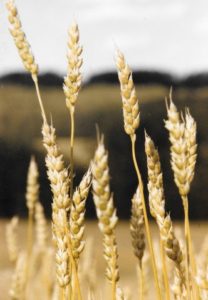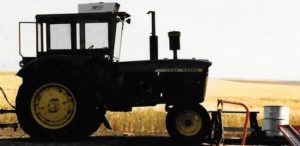
Wheat at our farm
Grain sales in Western Canada were at very low levels in 1969 and prices for wheat and barley were down on the world markets. However there was the likelihood of a huge inventory of grain to be harvested in 1970.
What to do? The Canadian Wheat Board (CWB) a Crown Corporation of the Government of Canada, controlled the sale of wheat and barley in the four western provinces. Otto Lang, the minister in charge of the CWB and a farmer from Humboldt, Saskatchewan came up with a plan ( Lower Inventory For Tomorrow – L.I.F.T.) by paying farmers to not plant crops in 1970. The government would pay $6.00 per acre to the farmers. Most farmers opted for this program and there were a total of 108,201 applications paid in this program. The cost to the federal government was $63 million.
Somehow these applications had to be processed.

Government of Canada 1970 location – courtesy of Google Maps
Government of Canada Regina, SK allocated office space to do this work. Temporary workers were hired and I as one of those. We were about 30 in number with a government supervisor. I was appalled, but not surprised, that the government purchased 30 new calculators for this job without paper tape! Can you just imagine checking an application with a number for the acres in each quarter section (and this could be several sections) and finally a total to be multiplied by $6.00. And no tape to check back your calculations. You really had to check every application at least twice to make sure you got the same answer.
This was my first and only job working for government: Federal, Provincial or City.
Some of the permanent staff here worked hard and some didn’t. In fact in the seven or so weeks I worked there I saw one woman whose desk and area around her desk had her potted plants and she did nothing but take care of these plants every day.
The L.I.F.T. program may have been instrumental in the diversifying of crops grown in the Prairie Provinces. Crop diversity was greatest in the parkland area and least in short-grass prairie. This began in earnest around 1993 and continued to 1996 when wheat production increased again due to higher prices. However since that time diversity has increased as pulse crops mature faster than grain crops which is so important with our short summers.
 Marketing prairie crops has changed dramatically since the sale of canola wasn’t part of the C.W.B. In fact the monopoly of the C.W.B. marketing all wheat and barley ended by federal legislation in 2012. The C.W.B. was sold in 2015 to G3 Global Canada a coast to coast grain handling company.
Marketing prairie crops has changed dramatically since the sale of canola wasn’t part of the C.W.B. In fact the monopoly of the C.W.B. marketing all wheat and barley ended by federal legislation in 2012. The C.W.B. was sold in 2015 to G3 Global Canada a coast to coast grain handling company.
Farmers now have the task of marketing their own crops.

Not the usual tractor these days – a John Deere Tractor.
Pool it or lose it is the most common answer to marketing as any crop in a large quantity is easier to sell than a small quantity. There are many hoops to jump through and planning for years ahead to be a successful farmer these days.
Hi Maureen. I also worked as a calculator for Operation LIFT at the Financial Building in Regina. It was educational for me in many ways: I learned about working in a bureaucracy, I Learned some things about farming, I learned about aerial photography, and I learned about working for the government. And it helped me pay for my university time. Trying very hard to remember the name of the manager. One of the two supervisors was J. G. Francis. Of the other I remember only that he was more enthusiastic about placing his horse-racing bets than doing the office work! Steve Lacey